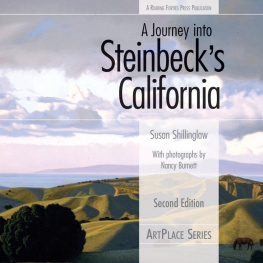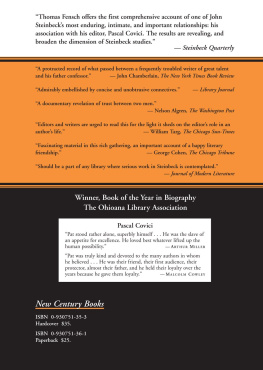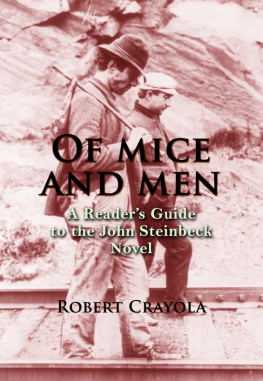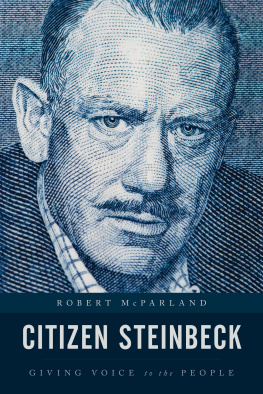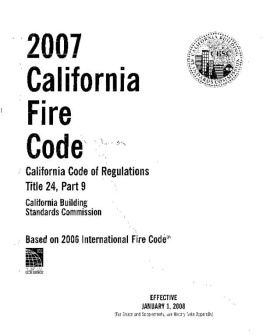
Roaring Forties Press
1053 Santa Fe Avenue
Berkeley, California 94706
All rights reserved.
Copyright 2006, 2011 by Susan Shillinglaw
Printed in China
ISBN 978-0-9846239-1-4
Library of Congress Cataloging-in-Publication Data
Shillinglaw, Susan.
A journey into Steinbecks California / Susan Shillinglaw ; with photographs by Nancy Burnett. -- 2nd ed.
p. cm. -- (ArtPlace series) Includes index.
Includes bibliographical references and index.
ISBN 978-0-9846239-1-4 (pbk. : alk. paper) -- ISBN 978-0-9846254-6-8 (epub) -- ISBN 978-0-9846254-7-5 (kindle) -- ISBN 978-0-9846254-8-2 (pdf) 1. Steinbeck, John, 1902-1968--Homes and haunts--California. 2. Steinbeck, John, 1902-1968--Knowledge--California. 3. Novelists, American--Homes and haunts--California. 4. Novelists, American--20th century--Biography. 5. California--In literature. 6. California--Biography. I. Burnett, Nancy. II. Title.
PS3537.T3234Z86646 2011
813.52--dc22
[B]
2011018233
For Bill Gilly,
who most certainly knows why
Contents
Preface to the Second Edition
John Steinbeck was a traveling man, restless and curious throughout his sixty-six years. Born in Salinas in 1902, he fled hometown proprieties as soon as he was able, enrolling in Stanford University at the age of seventeenalthough he had scant interest in earning a degree. When his student budget permitted, he went to San Francisco, where he savored his first independence living where he chose, doing as he wanted, eating at random when and where and what he liked. Still an undergraduate, he envisioned even greater freedom at sea, and planned a voyage to China on a merchant ship (nixed because he had no sailing experience), then considered riding horseback to Mexico, picking his way through the desert (no money for that). Distant horizons beckoned. When he left university in 1925without a degree in handhe sailed to New York City, expatriate from his own soil, yearning for cultural polish, determined to make it as a writer in the nations aesthetic hub. He lasted only a few months, the city having beaten the pants off me.
But the itch to travel remained, marking his life and his work. While California remained his touchstone, the place he returned to, the place he yearned for, John Steinbeck had an equally urgent need to sally forth. In the 1930s, he and his wife drove to Mexico and then took a ship to Scandinavia and Russia, where, he bragged on his return, they didnt meet a single worthwhile person. They went to Baja in 1940 with Steinbecks best friend, marine biologist Ed Ricketts, to collect invertebrates, and Steinbeck was planning another collecting trip with Ed the year Ed died, 1948. During World War II, Steinbeck was a war correspondent and after the war he covered wartorn Russia. The 1950s were a decade devoted to travel. He and his third wife, Elaine, would sail to Europe for the summer and fly to the Virgin Islands in the winter, he writing journalistic pieces along the way, published in popular magazines such as Colliers, Holiday, and Esquire. And in the 1960s, he drove across America with his dog Charley, circling back to his roots.
As he lived, so he wrote. Three of his most important books were travel narratives, Sea of Cortez (1941), A Russian Journal (1948), and Travels with Charley (1962). Several journalistic series focus on travel, in one way or another, from his first, The Harvest Gypsies, written in 1936, to his final series about Vietnam, Letters to Alicia, syndicated in American newspapers in 1966 and 1967. And many of his books are about characters as restless as he, Americans who look to California for the adventure and promise that he himself sought around the world: Lennie and George, Tom Joad, Adam Trask. Elaine Steinbeck reported to a friend that in 1958 John was putting the final touches on a new short novel, The Marshal of Manchou, a Don Quixote-ish story of a man in a small western town who gets so enthralled in adult westerns on TV that he goes out into the world to do Good. Very charming, funny, and touching.
That book was never published, but there surely was a bit of Steinbeck himself in the idealistic Marshal, out to do Good, to nudge readers into fuller understanding of others, whether fellow Americans or Mexican revolutionaries. Travelers like Steinbeck are adventurers. They are curious and some, like Steinbeck, want to burrow into the marrow of a place, to be an eyewitness to contemporary events. Some, like Steinbecks malcontents on The Wayward Bus, learn important lessons. And some, like Steinbeck, travel in order to better understand themselves as Citizens of the World, inhabitants of a region. For Steinbeck, to travel was to live fully, deeply, truly, also inhabiting a region.
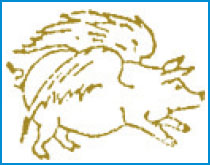
His personal stamp, which he settled on in the late 1930s, was a flying pig, Pigasus, and beneath he wrote his motto in Latin, To the stars on the wings of a pig in other words, Elaine explained, go as high as you can on the equipment youve got! That phrase suggests both creative yearnings and his own wanderlust.
But its also true that he was a homebody, and the paradox of flight from and return to California was the story of his life. Although he left his home state in the early 1940s, remarried in 1943, and settled in New York City in 1945, John Steinbeck never truly left California at all. You look like a Californian, an Okie boy told him in the 1930srugged, square-shouldered, intense, free-thinking, broad-humored. The West nurtured his soul, even when he was three thousand miles away, living in a New York apartment and finding watery solace at a weekend retreat in Sag Harbor, Long Island, a cottage by the sea not so very different from the one his father had built in Pacific Grove in 1904, two blocks from Monterey Bay.
California was, quite simply, home. In 1948, for example, he was living in New York City with his second wife and his world was falling apart. His health was bad, nerves shredded, stomach tight. He was taking antidepressants and felt himself in a kingdom of despondency after the death of Ed Ricketts. His second marriage was crumbling. He was being sued for breach of contract on a film of Cannery Row. What buoyed him during these grim months were thoughts of the book he had intended to write since 1932, the opus to his birthplace, East of Eden. He decided he should live in the Salinas Valley and considered buying property in Corral di Tierra, where his beloved Aunt Mollie had lived: My hunger for there is very great, he wrote in his journal.
That hunger was translated into story after story, from his college years at Stanford University through 1955, when a musical called Pipe Dream opened on Broadway. Based on a little-known sequel to Cannery Row, Sweet Thursday, the musical was one of Rodgers and Hammersteins few flops. Steinbeck complained that they didnt understand the material, his own delicate touch that made brothels homelike, madams decent, a marine scientist a gentle sage, and bums endearingly rough-edged, lonely like everyone else. Steinbecks West was an egalitarian place, where ordinary folks needed to be understood and heard. Steinbecks California fiction invites readers to the human carnival, where migrants and bums and bindlestiffs and farmers rub elbows, all yearning for something promised in the West, in California, the state where dreams are supposed to come true, where wanderlust is supposed to be satiated.
Next page
